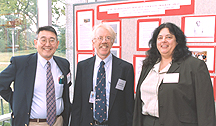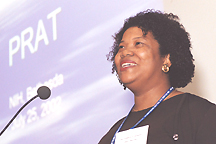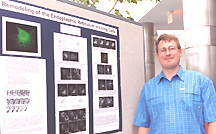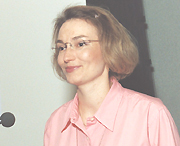| T
H E N I H C A T A L Y S T |
N
O V E M B E R – D E
C E M B E R 2002 |
|
|
CROSSING
PATHS ON THE ROAD TO PHARMACOLOGY:
PRAT FELLOWS MIX, MINGLE,
AND MOVE ON
|
|
"Pharmacology
is a very special area, and the PRAT
[Pharmacology Research Associate] program is a very special program," Peter
Blumberg told a gathering of individuals whose presence at a PRAT awards
ceremony in July signaled their likely agreement with his enthusiasm for the
field.
Chief of the Molecular
Mechanisms of Tumor Promotion Section, NCI, and chairman of the PRAT advisory
committee, Blumberg keynoted the first formal occasion to recognize those fellows
completing the NIGMS-sponsored PRAT program—this year there were seven.
The ceremony included a reception, a poster session, a plenary session, and
presentations of the research of four current PRATs. The newest class, comprising
six fellows working at five different NIH institutes, came on board October
7.
Established in 1965, the
PRAT program offers training, career advice, and networking opportunities to
postdoctoral researchers interested in the field of pharmacology. It is a two-year
program with the possibility for a third year and, like the field of pharmacology,
is cross-disciplinary. Research presented at the summer event ranged from the
discovery of new genetic targets for breast cancer drugs to the molecular mechanisms
of chemotaxis.
The fellows, who interact
regularly through PRAT-sponsored events, consider bumping shoulders with those
in other fields to be one of the most valuable aspects of the program. There
is a monthly seminar series at which second-year fellows present their work
and guest speakers elaborate on career options—not only research in various
environments but also in such lines as patent law, science education, and grants
administration.
Most PRATs gravitate to
research careers in academia—and most arrive at that destination. Of the
340 PRAT program graduates, more than 90 percent have continued in research
careers, with more than 60 percent of these in academia.
—Alisa
Zapp Machalek
 |
(Left):
Peter Blumberg
(center), chair, PRAT advisory committee, girded by Richard
Okita and Pamela
Marino (PRAT program co-directors)
(Right)
Juanita Sharpe,
a third-year PRAT fellow, speaks on "Cardiolipin modulation by the
Bcl-2 family members in apoptosis regulation"
|
 |
 |
(Left)
Erik Snapp,
newly graduated PRAT fellow, presents poster on "Remodeling of the
endoplasmic reticulum in living cells"
(Right)
Kristi Egland,
a second-year PRAT fellow, speaks on "Discovery of new breast cancer
genes encoding membrane and secreted proteins for use as immunotherapy
targets"
|
 |
| Coming
Soon: Next Class of PRATS |
|
The
deadline for applications to the NIGMS Pharmacology Research Associate
(PRAT) program
is January 3, 2003, for positions
starting in October 2003. The PRAT program supports two years of training
in NIH or FDA laboratories for postdoctoral candidates in the pharmacological
sciences and related research areas. These may include, but are not limited
to, molecular pharmacology, signal-transduction mechanisms, drug metabolism,
immunopharmacology, chemistry and drug design, structural biology, endocrinology,
bioinformatics, and neuroscience. PRAT fellows receive competitive salaries
as well as supply and travel funds to support research in their preceptors’
laboratories. Candidates apply in conjunction with an identified preceptor,
who may be any tenured or tenure-track scientist at NIH or FDA. For more
information or application materials, contact the PRAT program assistant
at 301-594-3583 or by e-mail.
ClinPRAT
A sister program
called Clinical Pharmacology PRAT, and nicknamed ClinPRAT,
was launched four years ago and is open to individuals with M.D. degrees.
It is designed to create a cadre of scientists in the clinical development,
evaluation, and therapeutic use of small molecule- and biotechnology-based
pharmacotherapy. For more information on this program, contact Art Atkinson
at 301-435-8791 or by e-mail<aatkinson@mail.cc.nih.gov>
or visit the ClinPRAT
website. 
|
Return to Table of Contents



